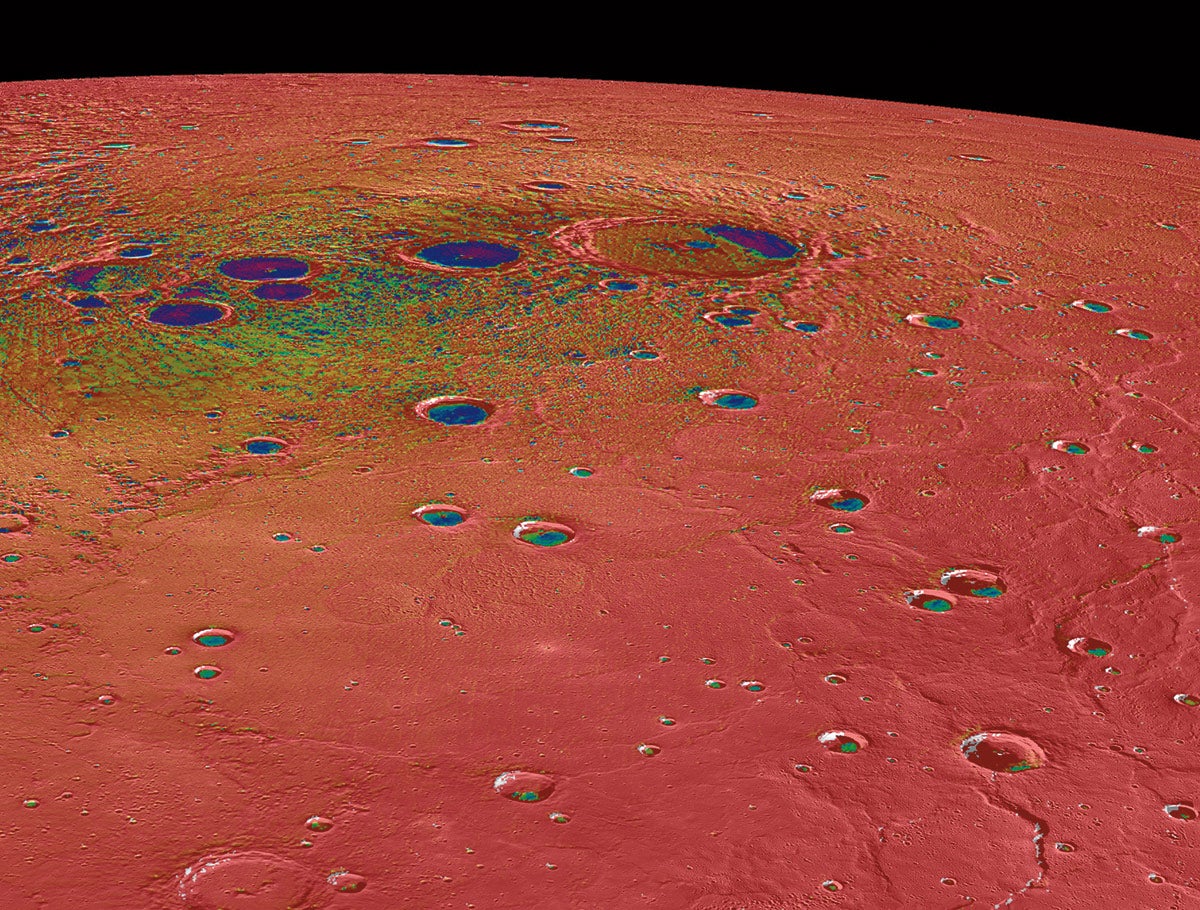lens
Mercury’s Mysteries
Exploring the first planet from the Sun
 IMAGE: NASA/JOHNS HOPKINS UNIVERSITY APPLIED PHYSICS LABORATORY/ CARNEGIE INSTITUTION OF WASHINGTONThis image, based on
IMAGE: NASA/JOHNS HOPKINS UNIVERSITY APPLIED PHYSICS LABORATORY/ CARNEGIE INSTITUTION OF WASHINGTONThis image, based on data the MESSENGER spacecraft collected, is of Mercury’s north polar region. Areas shown in red are sunlit and reach temperatures of greater than 400 Kelvin (260 degrees Fahrenheit); craters shown in purple remain permanently in shadow and can have temperatures as low as 50 Kelvin (minus 370 degrees Fahrenheit).
Steven Hauck was helping analyze data from NASA’s MESSENGER mission a decade ago when scientists discovered what he still considers “one of the coolest things that we found.”
That four-year orbiting trip around Mercury revealed a surface pocked with features found nowhere else and reminiscent of Swiss cheese. Dubbed “hollows,” they occur when rocks turn to gas and disappear into space.
Determining what type of minerals might do that and how common they are “will be important for understanding what Mercury’s crust was made of right after the planet formed,” said Hauck, PhD, a professor and chair of the Department of Earth, Environmental and Planetary Sciences at Case Western Reserve. Hauck has spent his career studying the mysteries of Mercury, as well as the evolution of other planetary bodies’ interiors and surfaces.

Steven Hauck
He’s also chair of NASA’s Mercury Exploration Assessment Group, a scientific advisory panel, and has participated in two studies that examined the feasibility of NASA someday setting a spacecraft on the planet.
Studying Mercury and other planets has value beyond better understanding a single celestial orb, Hauck said. “Because it’s so different in many ways from the other planets,” he said, Mercury “gives us an opportunity to really test our ideas about how planets work.”
Hauck recently shared some of his favorite facts about the planet closest to the Sun:
1. Mercury experiences double sunrises and double sunsets because it spins on its axis twice for every three rotations around the sun.
2. It has shrunk by 5½ miles over about 4 billion years. Other planets don’t show this level of shrinkage, although Hauck says phenomena such as the global shifting of continents through plate tectonics make it difficult to record shrinkage on Earth.
3. Mercury has the widest temperature variations from hot to cold—about 600 degrees—of any planet in the solar system. That’s thanks to the combination of the planet’s long solar day, its proximity to the sun and its negligible atmosphere.
4. Mercury doesn’t experience seasons because the tilt of its rotational axis is nearly zero, where the tilt of the Earth’s axis that gives us our seasons—when regions are pointed toward or away from the sun—is 23.5 degrees.
5. Although Mercury is the closest planet to the sun, it has ice in permanently shaded areas by its poles, which are some of the coldest places in the inner solar system and can reach minus 370 degrees Fahrenheit.





